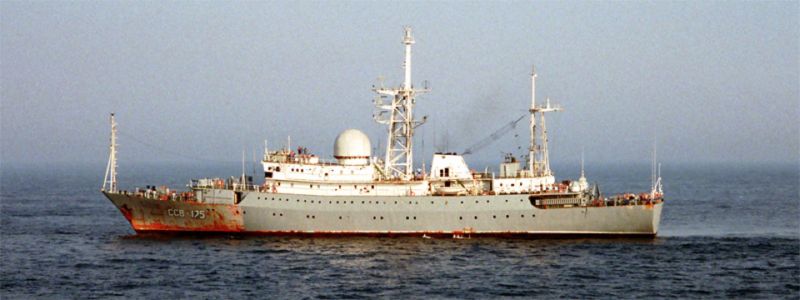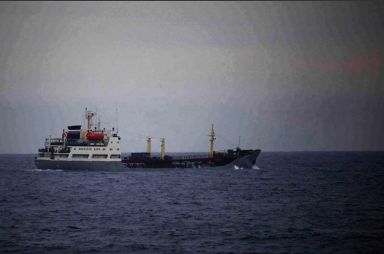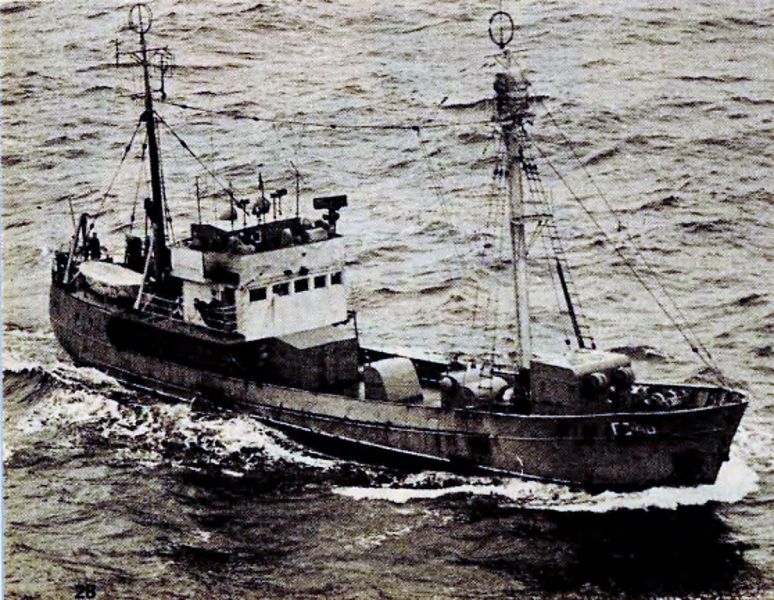 Реклама Google — средство выживания форумов :)
Реклама Google — средство выживания форумов :)
-
![[image]](https://www.balancer.ru/cache/sites/com/tu/turner/cdn/i2/cnnnext/dam/assets/128x128-crop/150120152010-nr-oppmann-russian-spy-ship-docks-havana-cuba-00000628-large-169.jpg)
Разведывательные корабли ВМФ [2]
Теги:
Odeen> Добавлю стоп-кадр с Westpac 89-90
Данный видео (стоп) кадр был сделан с борта USS Denver.
Данный видео (стоп) кадр был сделан с борта USS Denver.
Прикреплённые файлы:


Odeen> Нашел в "Одноклассниках" - ССВ-208. Наверно, "канадец" с "Пасекса-89(90)"...
Тут еще надо разбираться. На снимке - голландский ФР УРО типа "Кортенаэр". Если это F810, то это -
- "Банкерт", если F816, то это - "Абрахам Крайнссен". Я номер точно разобрать не смог. Я проверил, ни один из них в 1989-90 гг не был в зоне Индийского - Тихого океанов. Наоборот, оба корабля в тот или иной период входили в состав ПОС НАТО или действовали в Карибском море. Вот только "Банкерт" в 1987 г находился на СРМ, если я не ошибаюсь. А это значит, что данное фото с определенной степенью вероятности можно отнести к 1988 г, когда ССВ-208 совершал переход на ТОФ.
Но это - только мои предположения.
Тут еще надо разбираться. На снимке - голландский ФР УРО типа "Кортенаэр". Если это F810, то это -
- "Банкерт", если F816, то это - "Абрахам Крайнссен". Я номер точно разобрать не смог. Я проверил, ни один из них в 1989-90 гг не был в зоне Индийского - Тихого океанов. Наоборот, оба корабля в тот или иной период входили в состав ПОС НАТО или действовали в Карибском море. Вот только "Банкерт" в 1987 г находился на СРМ, если я не ошибаюсь. А это значит, что данное фото с определенной степенью вероятности можно отнести к 1988 г, когда ССВ-208 совершал переход на ТОФ.
Но это - только мои предположения.


Это сообщение редактировалось 14.02.2018 в 15:08
Javier G
новичок
Привет, меня зовут Хавьер, и я испанский. Я исследователь и изучаю период холодной войны во время войны Мальвинских островов / Фолклендских островов в 1982 году.
Я хотел бы знать, если кто-нибудь помнит, подробности присутствия судов (AGI) в водах Канарских островов и Гибралтарского пролива в этот период
Спасибо!
Я хотел бы знать, если кто-нибудь помнит, подробности присутствия судов (AGI) в водах Канарских островов и Гибралтарского пролива в этот период
Спасибо!


1989-1990, Персидский залив, ССВ-493 "Азия" с борта ЭМ "Меррилл". Автор - Randy Thompson, фото взято с сайта FACEBOOK.
Прикреплённые файлы:


Javier G
новичок
Сеута 80 Фото: LIBRO "EL ESTRECHO EN LA POLÍTICA DE SEGURIDAD ESPAÑOLA DEL SIGLO XX"
Прикреплённые файлы:


J.G.> Сеута 80 Фото: LIBRO "EL ESTRECHO EN LA POLÍTICA DE SEGURIDAD ESPAÑOLA DEL SIGLO XX"
I think that this photo for another thread

I think that this photo for another thread


Корабли космического флота
Здравствуйте! А не моли бы Вы дать инфо по судам КИК Космонавт Владислав Волков Космонавт Павел Беляев. Это суда постройки 1963-1966 года типа Вытегралес Перестроенные в 1977 году в суда КИК. Списаны в 1996 - 2000 году Мне нужны их первоначальные названия. Космонавт Георгий Добровольский бывший Назар Губин Космонавт Виктор Пацаев бывший Семен Косинов Один из вышеуказанных бывший Иван Черных. Заранее благодарен info// Морской

ССВ-80, конец 80-х годов. Автор - Mike Romero, взято с сайта FACEBOOK
Прикреплённые файлы:


Подписано фото как Юпитер ...
Больше ничего по фото ...
Больше ничего по фото ...
Прикреплённые файлы:


Пара снимков одного из тихоокеанских тунцеловов с борта USS Enterprise. Взято с сайта FACEBOOK.
Прикреплённые файлы:


2018-02-22 СРЗК "Федор Головин" в Английском канале в сопровождении английского СКР HMS "Mersey". В составе ОБК ВМФ РФ переход совершали БДК "Александр Отраковский" и ТН "Ельня". Фото с борта вертолета Wildcat c АБ Йовилтон. Снимок взят с сайта FACEBOOK.
А виде доступно по ссылке:
HMS Mersey monitors Russian spy ship task group as it sails past UK
Patrol ship HMS Mersey and a Wildcat helicopter from RNAS Yeovilton were dispatched to follow the progress of three Russian warships/vessels as they made their way up the Channel. Full story: http://ow.ly/k08030iyt1R
А виде доступно по ссылке:
HMS Mersey monitors Russian spy ship task group as it sails past UK
Patrol ship HMS Mersey and a Wildcat helicopter from RNAS Yeovilton were dispatched to follow the progress of three Russian warships/vessels as they made their way up the Channel. Full story: http://ow.ly/k08030iyt1R
Прикреплённые файлы:


Это сообщение редактировалось 25.02.2018 в 17:59
2017, февраль, ВПС. Вроде, не было тут такого снимка.
Взято здесь: Russian spy ship spotted off East Coast - AR15.COM
Взято здесь: Russian spy ship spotted off East Coast - AR15.COM
Прикреплённые файлы:


По сообщениям газеты Гардиан (Тринидад и Тобаго) 23-25.02.2018 ССВ-175 "Виктор Леонов" совершил повторный заход в Порт оф Спейн. Взято с сайта газеты:


Russian spy ship in T&T waters
The Russian intelligence-gathering vessel Viktor Leonov returned to Trinidad for a second time this year and was docked near the Hyatt yesterday. The vessel is expected to depart today. When the Sunday Guardian visited the dock before noon, about 15 of the ship's crew in brown uniforms were at the stern of the ship on their down time, smoking and using their cellphones. An officer in camouflaged fatigues was talking with one of the ship's officers while another interacted with the crew. There were also two T&T Coast Guard vessels—the TTS Gaspar Grande and TTS Carli Bay—moored near the Femmes du Chalet Breakfast Shed area. The Viktor Leonov departed T&T on the morning of January 15 after spending five days. Many people have been asking what the ship is doing in Trinidad and its purpose. The 300 ft-long ship is armed with anti-aircraft missiles. The Vishnya or Meridian-class intelligence ship, which has a crew of around 200, went into service in the Black Sea in 1988 before it was transferred seven years later to the Northern Fleet, according to Russian media. Meanwhile, Marc De Verteuil who tracks American military aircraft in T&T said that a US military C-32B special ops aircraft, call sign NaRK73, landed at Piarco Airport yesterday. “We have or recently (at least up until Carnival) had a USAF U28A flying missions over Trinidad, De Verteuil said. He said it was based at the Air Guard hangar. De Verteuil said there was a USAF C146A Wolfhound (military derivative of the Do 328) that regularly made visits to Piarco and that plane is used primarily by special ops. He said it was clear that foreign intelligence services were operating here because of what he can only presume was a very serious threat. The US armed forces usually deploy ships and aircraft to shadow the Russian spy ship. Close ties to Venezuelan Govt Researcher Daurius Figueira said one of the reasons for the ship passing through T&T was the country's close proximity to Venezuela geographically. "Venezuelan president Nicolás Maduro is very close to Russia and Iran who are involved in the conflict in Syria," Figueira said. "Even with the sanctions imposed on Venezuela by American President Donald Trump, Russia continues to show solidarity with Maduro by forgiving his debt to Russia. "Russia is the primary supplier of military aid, along with financial and technical support to the Venezuelan armed forces. Totalling more than US $11 billion, Venezuela represents 75 per cent of Russia's total foreign military sales in the region." He said the Russian state-owned energy firm, Rosneft, had also provided Venezuela with an estimated US $17 billion in financing since 2006. Figueira said Russia was also increasing its naval activity worldwide and was doing the same thing with its long-range bombers. He said Russian President Vladimir Putin had extended his hands to Cuba giving the country a lifeline with oil as Venezuela cannot maintain its obligations to Petrocaribe. The same AGI (auxiliary, general intelligence) ship was docked in Havana on January 20 2015, a day before the start of historic US-Cuba talks aimed at normalizing diplomatic relations. A security threat to underwater communication cables Figueira said the Americans felt that the ship represented a threat to the security of underwater communication cables connecting the North and South Atlantic mapping their layout. Steffan Watkins, a Canadian security analyst who closely tracks Russian ship movements, said in The Washington Free Beacon in January 17 that he traced the Leonov's movements beginning with its mid-December sail from northeastern Russia and crossing the English Channel on Christmas Eve. He also discovered Facebook postings by a Russian suspected of being one of the Leonov's crew members that showed photos of the crew's shore leave in Port-of-Spain. Watkins said given the ship's past deployments which lasted around six months and included stops at Russian-allied states such as Cuba and Nicaragua, the ship usually spends around two months spying off the East Coast of the US where there are naval bases and submarine groups. Watkins said he believed their mission was to take inventory of underwater sensors, military undersea cables, sonar, radar and spy on rocket launches at Cape Canaveral. No confirmation why ship is in local waters Yesterday, when contacted, a senior official at the T&T Defence Force (TTDF) confirmed the dates of the ship’s first visit, from January 10 to January 15. Asked if the TTDF knew the reason for the ship’s second docking and if they knew that it is believed to be a Russian spy ship, the TTDF senior official’s response was “Are you all aware that all military vessels have surveillance equipment?” Pressed further, the TTDF official said he did not have any information and redirected the Sunday Guardian to the Ministry of Foreign Affairs. “They will have what you’re looking for. The diplomatic note from foreign governments go to them.” The Sunday Guardian was told that before any foreign vessel enters T&T waters they first have to undergo an interview by the Maritime Division of the Ministry of Works and Transport. // www.guardian.co.tt
Прикреплённые файлы:


Кое-что об инциденте с ГС-34 в 1959 году:


23-02-2018 Порт оф Спейн, Тринидад и Тобаго. Еще один снимок ССВ-175 из газеты Trinidad Express. Автор снимка - Stephey Doobay.
Прикреплённые файлы:


20-02-2018 СРЗК "Федор Головин" в районе побережья Португалии в составе ОБК ВМФ РФ (БДК "Александр Отраковский", ТН "Ельня"). Фото с борта португальского ФР "Антонио Энеш". Взято из сети TWITTER.
Прикреплённые файлы:


ГС-46 в районе побережья Исландии. Взято с норвежского печатного издания Roede Garde No 6/7, 1975. Полностью тут: http://www.akp.no/ml-historie/pdf/ungdom/rode_garde/rg_1975_06_07.PDF
Прикреплённые файлы:


ССВ-516 "Лира" , Балтийск, 1981-82 до весны ...
От Протопопова фото ...
От Протопопова фото ...
Прикреплённые файлы:


DDR> ССВ-516 "Лира" , Балтийск, 1981-82 до весны ...
DDR> От Протопопова фото ...
Мне кажется, фото относится к январю 1980 года, т.к. Лира в начале 1980 года прибыла в Горячие Ручьи, если я не ошибаюсь.
DDR> От Протопопова фото ...
Мне кажется, фото относится к январю 1980 года, т.к. Лира в начале 1980 года прибыла в Горячие Ручьи, если я не ошибаюсь.


info> не выяснили где ГС-50 построен и когда?
Насколько я знаю, ГС-50 не входил в состав сил разведки ВМФ СССР. Он выполнял функции обычного гидрографа на ЧФ. Судя по определенным признакам, ГС-50 был логгером отечественной постройки. Другими данными не располагаю. Наверное, они есть в Интернете.
Насколько я знаю, ГС-50 не входил в состав сил разведки ВМФ СССР. Он выполнял функции обычного гидрографа на ЧФ. Судя по определенным признакам, ГС-50 был логгером отечественной постройки. Другими данными не располагаю. Наверное, они есть в Интернете.
Прикреплённые файлы:


 Реклама Google — средство выживания форумов :)
Реклама Google — средство выживания форумов :)
info>> не выяснили где ГС-50 построен и когда?
O.S.> Насколько я знаю, ГС-50 не входил в состав сил разведки ВМФ СССР. Он выполнял функции обычного гидрографа на ЧФ. Судя по определенным признакам, ГС-50 был логгером отечественной постройки. Другими данными не располагаю. Наверное, они есть в Интернете.
Фото не открывается. Данных в инете нет.
Подсказали.предположительно ГС-50 — одна из тех 10 единиц, которые были построены в 1957 году на ССЗ 196 (Судомех) в Ленинграде
я на нем был,базировался на Ломоносов.там не было доп. каких то помещений. Обычные для СРТ каюты и трюма
причем помню шильдики на каютах-рыбацкие. И таким же был ГС-48
O.S.> Насколько я знаю, ГС-50 не входил в состав сил разведки ВМФ СССР. Он выполнял функции обычного гидрографа на ЧФ. Судя по определенным признакам, ГС-50 был логгером отечественной постройки. Другими данными не располагаю. Наверное, они есть в Интернете.
Фото не открывается. Данных в инете нет.
Подсказали.предположительно ГС-50 — одна из тех 10 единиц, которые были построены в 1957 году на ССЗ 196 (Судомех) в Ленинграде
я на нем был,базировался на Ломоносов.там не было доп. каких то помещений. Обычные для СРТ каюты и трюма
причем помню шильдики на каютах-рыбацкие. И таким же был ГС-48


Это сообщение редактировалось 16.03.2018 в 16:54
Copyright © Balancer 1997..2025
Создано 10.10.2007
Связь с владельцами и администрацией сайта: anonisimov@gmail.com, rwasp1957@yandex.ru и admin@balancer.ru.
Создано 10.10.2007
Связь с владельцами и администрацией сайта: anonisimov@gmail.com, rwasp1957@yandex.ru и admin@balancer.ru.
 Old Seaman
Old Seaman


 инфо
инфо инструменты
инструменты Javier G
Javier G
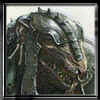





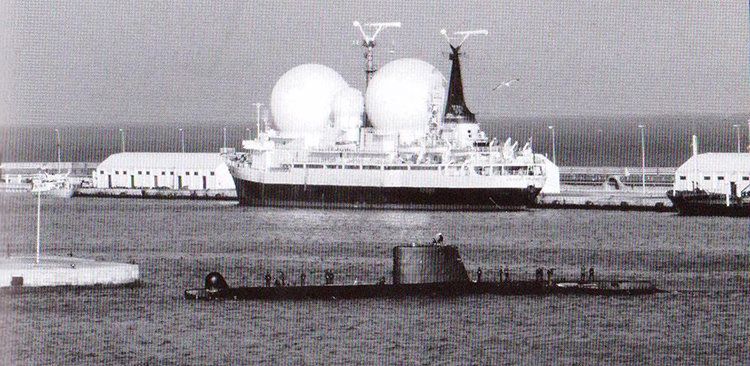


 DDR
DDR



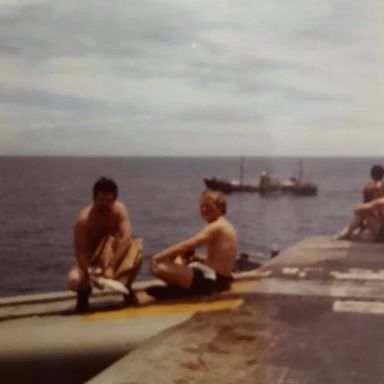
 Novice1975
Novice1975












